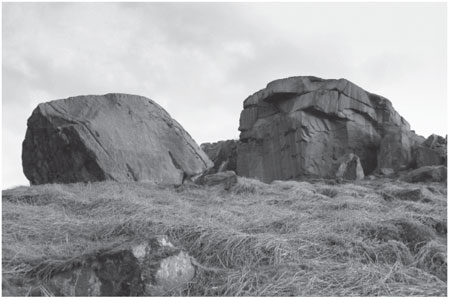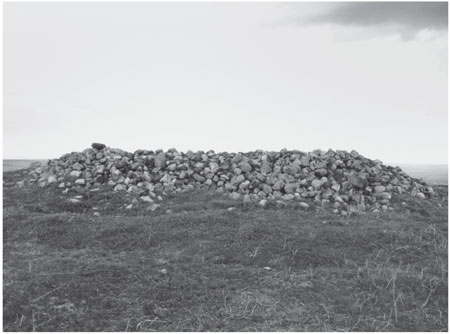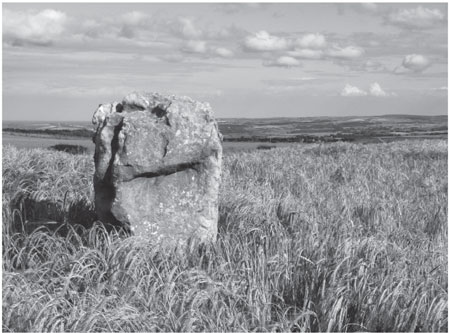Folklore of Yorkshire (9 page)
Read Folklore of Yorkshire Online
Authors: Kai Roberts

Moreover, before man was readily able to shape his own environment through the advancement of technology, giants were a particularly apposite metaphor for his place in the world. As the psychologist Brian Bates writes in relation to how giants were perceived by our Anglo-Saxon and Norse ancestors, ‘Cleverer beings may have come along since and elaborated the world but the basic structure and dynamics of life were in the hands of the giants … The giants reminded them that human life existed within a universe of immense forces.’ Essentially this remained true until the Industrial Revolution and just as the upland fastnesses of Yorkshire responded well to particularly austere forms of Christianity such as Methodism, they similarly identified with the giants’ embodiment of the brute reality of nature.
Like the changeable elements of the Pennine hills, giants were quick to anger and the summits and valleys of that range exhibit the consequences of their temper. Anomalous stone boulders or outcrops were often attributed to the work of giants, flung from an eminence nearby and often they were in fact glacial erratics, carried and deposited from some hilltop strata by retreating ice-sheets several millennia ago. Such a rock once sat about a mile from Leeds, beside the Bradford road. It was known as the Giant’s Stone and local legend related that it had been thrown there from a hill near Armley on the opposite bank of the River Aire. Indentations on the boulder were imagined to represent the giant’s fingerprints.
Meanwhile, the Carlow Stone was supposedly thrown by a giant from the summit of Addleborough in Wensleydale. He was aiming at his adversary the Devil, who had taken up a position on a hilltop across the valley, but his pitch fell short and it came to rest on the shores of Semer Water below. A similar story is told about the creation of Almscliffe Crag, a substantial gritstone excrescence that sits several hundred feet above lower Wharfedale and provides a focal point from miles around. In this case, the Devil and the giant, Rombald were fighting on Ilkley Moor when the Devil overshot and his missile landed some eight miles away to form Almscliffe Crag.

The Cow and Calf on Ilkley Moor, stepping stones of the giant Rombald. (Kai Roberts)
Rombald is the tutelary giant of that region and supposedly gave his name to Rombald’s Moor – the upland massif between Airedale and Wharfedale, of which Ilkley Moor forms the northern edge. In some versions of the legend, the stray missile which formed Almscliffe Crag was thrown at Rombald not by the Devil but by the giant’s formidable wife. Rombald himself is supposed to be responsible for the natural basins which score the surface of the Crag, which he created when he strode across to Almscliffe from his home above Ilkley and left his footprints embedded in the rock. On another occasion when the giant was stepping between these two points, he missed his footing and gouged a mark in face of the Cow, largest of the famed Cow and Calf Rocks – a favourite recreation spot for locals and day-trippers alike for many centuries.
Rombald’s wife was also credited with the Hitching Stone, a huge boulder on Keighley Moor above Cowling, reckoned to be one of the largest single pieces of rock in the entire county. This monolith is further distinguished by a tubular cavity which runs for 20 feet through the rock at an angle of forty-five degrees from the top of the stone to a substantial recess on the west rock-face, known as the Druid’s Chair. Geologists believe this feature was formed by a fossilised tree which once ran through the boulder but has since corroded away. Local folklore, however, claims that the cavity is the result of the female giant driving a broom handle into the stone and flinging it over her head from Rombald’s Moor!
As Yorkshire giants go, the fame of Rombald and his wife was matched only by that of Wade and his clan, who occupied the North York Moors around Eskdale and indulged in similar behaviour. Legend records that Wade had a wife named Bel and a proportionally gigantic infant son. One day, the child had been left to his own devices whilst Bel milked her herd of cows on Swarth Howe above Aislaby, but growing impatient for attention, he took a huge rock and hurled it at his mother. For once in such a story, the giant’s aim was true and it struck Bel with enough force to send her flying to the ground where she left the imprint of her form in the rocks. Sadly, the stone that supposedly bore the impression of the giantess has long since been quarried away.
Sometimes giants not only leave their mark on the landscape, but become personified in the landscape itself. A nearly forgotten tale from West Yorkshire relates that a tribe of giants once dwelled in Magdale near Huddersfield. When a daughter of this tribe went missing, her frantic father scoured the surrounding countryside until he heard that she had last been seen on the hills above Holmfirth. The giant leapt from Scar Top at Netherton with such force that he left his footprint embedded in a stone there, and landed at Wolfstones Height, where he found his daughter’s prostrate form. At first he thought she was merely sleeping, but as he drew closer he saw that she had succumbed to exposure and died. He left her in that place to rest, which is why the summit of Wolfstones Height forms the simulacrum of a recumbent child and is known locally as the Child o’th’Edge.
Another West Yorkshire legend recalls a more solitary and rather less tender giant, who made his home on the moors above Haworth and quickly became the scourge of the district. To sate his considerable appetites he would steal the livestock from local farms and valuables from travellers on the road across the tops. For many years, his neighbours turned a blind eye to the giant’s behaviour, as they were afraid to confront such a terrible monster. However, during one particularly harsh winter when food was scarce, the giant began to eat people. At this point, the local folk finally decided that they could tolerate no more and they formed a mob to drive their tormentor out.
Like many of his race when confronted with an equal adversary, the giant proved to be a coward. He saw the mob coming and tried to flee, but they pursued their quarry at length and caught the brute at the Forks House stile. Their numbers were such that they were able to easily overcome the giant and decapitated him, allowing his head to roll into the delph below. His body, meanwhile, turned to stone and it is said that a fragment of the giant’s petrified form can still be seen beside the path which leads from the Brontë waterfalls to Top Withins. This relic is known as the Cuckoo Stone, although authorities are divided as to whether it is actually a natural earth-fast rock or an artificial standing stone.
If the Cuckoo Stone was an ancient standing stone, this would be entirely consistent with other giant lore, as local legend is just as ready to attribute the anomaly of ancient megaliths to the work of giants. A substantial Bronze-Age burial cairn on Burley Moor (part of the Rombald’s Moor massif) known as Little Skirtful of Stones was variously credited to Rombald or his wife. In one version of the tale, his wife spilled the stones she was carrying in her apron whilst stalking across the moor in pursuit of her husband. In another, the stones were dropped by Rombald himself as he carried them to construct a bridge over the River Wharfe in the valley below. Similar tales are told of the creation of the less well-preserved Great Skirtful of Stones nearby, although some sources suggest this cairn in fact marked the grave of the giant.

Little Skirtful of Stones on Rombald’s Moor, spilled by the giant’s wife. (Kai Roberts)
The motif of a giant’s grave was frequently attached to actual ancient burial sites, suggesting that folk may have dimly recognised the purpose of such monuments long before barrow-digging antiquarians confirmed it. The substantial dimensions of such tombs must have seemed fit for giants and there are a number of places known as ‘Giant’s Grave’ spread across the county. Although many lack any detailed narrative, their names remain as a clue to the associated lore. Sadly, a number have been entirely destroyed by deep-soil ploughing and stone theft over the centuries, but a particularly notable example can still be seen in Halton Gill, beneath the distinctive bulk of Pen-y-ghent. The badly damaged site remains largely inscrutable, but it is thought to represent the remains of a late Neolithic chambered cairn or an early Bronze Age round barrow.
The remains of the chambered cairn known as Stony Raise on the flanks of Addleborough in Wensleydale represent the largest example of such a monument in Yorkshire, even after a great quantity of stone was removed for building material in the early nineteenth century. It is scarcely surprising that such an imposing site became associated with the activity of giants. The cairn was supposedly created when a giant transported a heavy chest of gold from Skipton Castle to Pendragon Castle in the Eden Valley. As he crossed Addleborough, the burden became too great and he collapsed, letting the horde fall to the ground beside him. This accident caused the giant to blaspheme and at this exhortation the earth itself rose over the chest in pious defiance.

Wade’s Stone near East Barnby, grave marker of the legendary giant. (Kai Roberts)
Meanwhile, Wade was supposedly buried beneath a standing stone known as Wade’s Stone or Wade’s Grave, near East Barnby. There was once a second stone some 12 feet away from the first and it was believed that these two marked his head and feet respectively. This site stands a small distance from the shell of Mulgrave Castle, also reputedly the work of Wade. The ruins seen today are actually the remains of the second castle to have stood on the site, constructed in the late eleventh century by Nigel Fossard, who was gifted land around Whitby by the Conqueror himself, and not destroyed until 1647 on the orders of the Long Parliament, following its use as a Royalist garrison during the Civil Wars.
However, the Norman castle replaced an earlier Saxon fortification and it was this building which was credited to Wade. In this version of Wade’s legend, he was Duke Wada, a Saxon noble and one of the conspirators who murdered Ethelred, King of Northumberland, around
AD
849-862. The story was first recorded by William Camden in his seminal antiquarian work,
Britannia
, published between 1586 and 1607. He also notes that, ‘Here within the hill between two entire and solid stones above seven foot high (Wada) lies entombed: which stones because they stand eleven foot asunder, the people doubt not to affirm that he was a might giant.’ Nonetheless, there is no corroborative evidence for Camden’s Duke Wada, so it seems probable that this is a back-formation and the legend of the giant Wade circulated in these parts long before the name of the Saxon duke.
Local legend also relates that Wade built Mulgrave Castle at the same time as his wife Bel was building Pickering Castle, but having only one hammer between them, they would regularly throw it to each other across the moors. To facilitate their movement across this hilly terrain, the giants were supposed to have constructed Wade’s Causeway – actually a well-preserved Roman road running from Eskdale to Malton across Wheeldale Moor. Legend claims Bel used this road to access her herd of cattle for milking. The giantess seems to have been particularly associated with her cattle and during the eighteenth century, credulous visitors to Mulgrave Castle were shown the jawbone of a whale and told it was the rib of one of Bel’s cows.
